|
Thurs., May 3
1:00 p.m.
ALCPG ILC Physics and Detector Seminar - Hornets' Nest WH-8XO
Speaker: J. Repond, Argonne National Laboratory
Title: Status Report of RPC/GEM Vertical Slice Test
2:30 p.m.
Theoretical Physics Seminar - Curia II
Speaker: M. Pospelov, University of Victoria
Title: Particle Physics Catalysis of Big Bang Nucleosynthesis
3:30 p.m.
DIRECTOR'S COFFEE BREAK - 2nd Flr X-Over
THERE WILL BE NO ACCELERATOR PHYSICS AND TECHNOLOGY SEMINAR TODAY
6:00 p.m.
UTeV Seminar - 1 West
Speaker: A. Chou, Fermilab
Title: Ultra High Energy Cosmic Rays
Fri., May 4
3:30 p.m.
DIRECTOR'S COFFEE BREAK - 2nd Flr X-Over
4:00 p.m.
Joint Experimental-Theoretical Physics Seminar - 1 West
Speaker: J. Hubisz, Fermilab
Title: Tools for the LHC: Beyond the Standard Model
8:00 p.m.
Fermilab International Film Society - Auditorium
Tickets: Adults $5
Title: Grizzly Man
Announcement
Real Time Computing 2007 will be held at Fermilab on April 29 - May 4, 2007
Click here for more information.
Click here for NALCAL,
a weekly calendar with links to additional information. |
Thursday, May 3
-Minnesota wild rice w/ chicken
-Tuna melt on nine grain
-BBQ ribs
-Chicken casserole
-Buffalo chicken wrap
-Assorted pizza slices
-Toasted pecan chicken salad
Wilson Hall Cafe Menu |
Thursday, May 3
- Tortilla chicken soup
- Halibut Veracruz
- Chipotle mashed potatoes
- Vegetable of the season
- Profiteroles stuffed w/ fruit
Wednesday, May 9
Lunch
- Roast pork loin
- Orange roasted carrots w/ honey
- Pea pod salad w/ radishes
- Apple walnut raisin strudel
Chez Leon Menu
Call x4598 to make your reservation. |
|
|
CMS Pixels Group sees big picture with first shipment
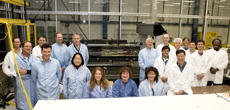 Members of the CMS Pixels Group with their first completed half-cylinder, one of four for the CMS Pixels detector.
Members of the CMS Pixels Group with their first completed half-cylinder, one of four for the CMS Pixels detector.
Last Friday morning, dozens of CMS Pixels group members at Fermilab celebrated the news that the first of the four components of the pixels detector had made it safely across the Atlantic to CERN. "This is a big milestone for us," said Simon Kwan of the Particle Physics Division's CMS department. "For CMS, this is a major piece of equipment, and to ship this to CERN successfully is thrilling."
University of California at Davis physicist John Conway and post-doc Ricardo Vasquez had hand-carried two metal briefcases containing the most fragile parts of the detector -- close to six million electrical connections arranged in half-disks -- on a flight from Chicago to Switzerland without damage. "This is definitely stressful. It is a big responsibility to carry so many people's work," Vasquez said. Each of the detector's four half-cylinders, assembled at Fermilab, will be photographed and have the half-disks removed before being shipped to CERN. Each of the half-disks will be carried by hand.
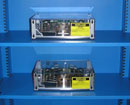 |
| The two half-disks of the CMS Pixels detector's first half-cylinder sit in dry boxes at CERN. The disks were hand carried from Chicago. |
When completed, the CMS Pixels detector will contain four half-cylinders assembled upstream and downstream of the proton-proton LHC interaction point. Inside each of those cylinders will be two half-disks filled with pixel detectors called plaquettes mounted on plates. The pixels will track charged particles flying out of the experiment.
Research and design on the CMS pixels detector began in 1995, led by Bruno Gobbi of Northwestern University. It took more than 10 years to get to the assembly, and has taken a little less than a year to put together the first half-cylinder. A significant element of the R&D process involved the depth and magnitude of the project, which involves extensive design, prototyping and testing, and a large international collaboration. "There is so much collaboration," said PPD's Alan Hahn. "I don't think that any one group could do it by themselves." Each component of the cylinder and the half-disks has to be thoroughly tested before it can move on to the next level of assembly. Although most of the final hands-on assembly work is done by SiDet staff at Fermilab, Purdue University performs significant work in assembling the plaquettes, and Kansas State University tests the flexible circuit boards, Hahn said. Testing is performed at SIDET by graduate students and postdocs led by University of Nebraska collaborators.
Kwan said that the team hopes to deliver all pieces of the CMS pixels detector to CERN by the middle of fall. He plans to arrive at CERN on May 14 to reinstall the two half-disks into the half-cylinder.
-- Rhianna Wisniewski
|
Dig in to help Fermilab celebrate Arbor/Earth Day
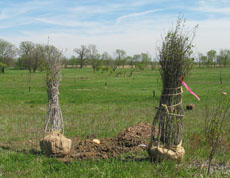 Trees sit south of the West Wilson Avenue Guard house waiting to be planted.
Trees sit south of the West Wilson Avenue Guard house waiting to be planted.
Bring your shovel, boots and gloves and celebrate Earth Day and Arbor Day with Fermilab, today from 11:30 a.m. to 1 p.m. About 55 native hardwood trees will be planted near the West Wilson Guard House, by Roads & Grounds staffers and lab volunteers. See map
"Planting trees helps improve the natural landscape and gives people the sense that they are helping the lab, which they are," said Mike Becker, Roads & Grounds manager.
The tree planting is among many examples of Fermilab's mission of land stewardship, which also formed the basis for a display at the recent Batavia EnvironExpo. "We wanted to convey the environmental message of the lab," said Paul Kesich, environmental protection group manager in Environment, Safety and Health. "We focused on our recycling efforts and land management."
The rain date for tree planting is May 7. For more information, visit the lab's Nature/Ecology Web site.
-- Kate Raiford
|
Lab trying to get the best of geese defending their nests
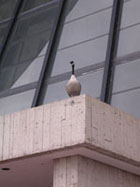 |
A goose stands on a ledge outside the entrance to Wilson Hall. Photo by Fermilab's Angela Bellavance. |
In the last few weeks, aggressive geese have caused problems across the Fermilab site. As geese and human beings are trying to occupy the same space during the goose nesting season, finding an acceptable form of peaceful coexistence is a challenge. For members of FESS Roads and Grounds and other lab employees handling the problem, it is a frustrating game of balance that involves geese population control and deterrent measures of varying kinds.
"We realize the magnitude of the problem," said ecologist Rod Walton of FESS. "The lab has taken many steps toward mitigating the problem, even if we don't publicize every measure that we take."
After a Technical Division employee was attacked by a goose and missed several days of work, TD Associate Head Romesh Sood was concerned that the lab might be overlooking a dangerous situation. "This is not the first time a goose has attacked. Employees were asking if the lab cared more about the birds than the people," said Sood. "I took it to the highest level and found out the lab is responding very well."
Bill Griffing, head of ES&H, explained that the lab has used a number of measures over the years to deter the geese from nesting in frequently traveled lab areas, including putting netting on the ground, spraying noxious non-toxic substances on the grass, and installing noisemakers. But the goose population lives here year 'round; eventually, Griffing said, they realize that those measures aren't threats. Currently, Griffing and Walton are working on removing nests and on other population control measures. This week they plan to bring in Border Collies, with the dogs herding the geese until, ideally, the tired-out geese leave.
The goose mating season typically ends in April, so geese are expected to remain highly aware of humans, and can be potentially aggressive until their goslings are born. Tips on how to stay safe around aggressive geese can be found in the April 2 Safety Tip.
-- Rhianna Wisniewski
|
MSNBC.com
May 2, 2007:
Extrasolar planet the heavyweight champ
Massive body takes just more than five days to circle its parent star
Astronomers have found the heavyweight champion of extrasolar planets in the form of an odd alien world slightly bigger than Jupiter, but more than eight times as massive.
Read more |
|
|
Breaking down the electron
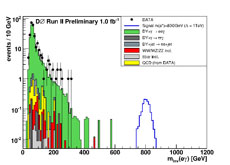
This figure shows the reconstructed invariant mass of the candidates for excited electron decay (electron and photon). The figure contains the expected events from known processes (filled histograms), the observed data (black points), and an example of an excited electron signal with a mass of approximately 850 times the proton mass.
Particle physicists make their living tearing things apart. To understand the laws of the universe, you begin by finding the fundamental building blocks of matter. By tearing apart the atom, scientists have systematically discovered the nucleus, the nucleon (comprising protons and neutrons), and the quark. By adding leptons (electrons, muons, neutrinos) to the six known quarks, physicists have identified three generations of matter particles that they believe are fundamental or indivisible; they cannot be torn apart. Each generation includes two quarks, a charged lepton, and a neutrino, but scientists cannot explain exactly why there are three and only three such groups.
One possible explanation is that these fundamental particles are actually composed of smaller particles. If this were true, then particles like the electron (or muon) could be coaxed into excited states. These excited electrons should have the properties of normal electrons, but much higher masses. As in the processes of fluorescence and phosphorescence, these excited electrons would decay into their ground state by emitting a photon. This process is analogous to a marble on a hill (excited state) rolling to the bottom (ground state) and acquiring some momentum in the process. Although the mass of an excited electron is not predicted, the decay products (an electron and photon) would together reveal the excited electron's true mass.
If electrons were composite particles, theory predicts that excited electrons could be produced in the Tevatron's proton/anti-proton collisions. Physicists at the DZero experiment have performed a search for excited electrons in one inverse femtobarn of data. This search found no excess of events beyond those predicted by known Standard Model processes, and allows DZero researchers to set limits on the possible mass of excited electrons and the potential size of any internal structure. For a model predicting electron structure as small as 1/5000th of the size of the proton, an excited electron with a mass below ~800 times the proton mass is excluded. But with more data provided daily by the Tevatron, DZero physicists remain vigilant in seeking to uncover the smallest building blocks of our universe.
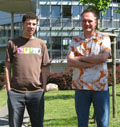
| Volker Vorwerk (left), Arnd Meyer (right), and Thomas Hebbeker (not pictured) of RWTH Aachen University designed DZero's search for excited electrons. |
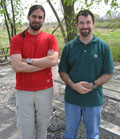
| Gustavo Otero y Garzon of the University of Illinois at Chicago (left) and Ken Herner of SUNY, Stony Brook (right) are DZero's current "Trigger Meisters." Their hard work in maintaining a highly robust and efficient trigger list and prescale set is essential for all DZero analyses. |
|
Little Particles, Big Implications
 |
| Schematic picture of the MiniBooNE detector. |
Neutrinos -- tiny, elusive particles that abound in nature. They're hard to see and they rarely interact with other particles, yet they have huge implications for particle physicists who are trying to understand matter and the origins of the Universe.
Read More
|
|
|
Lira Ensemble: A Polish musical celebration on May 5
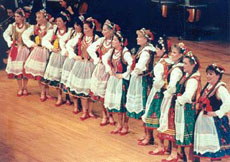 Lira Singers and Dancers will present "A Polish Musical Celebration" on Saturday, May 5.
Lira Singers and Dancers will present "A Polish Musical Celebration" on Saturday, May 5.
The Lira Singers and Dancers will present "A Polish Musical Celebration" at the Fermilab Arts Series in west suburban Batavia, Illinois, taking place in Ramsey Auditorium, located in the high rise building of the Fermi National Laboratory, Kirk Road & Pine Street, on Saturday, May 5 at 8 p.m.
The concert celebrates May 3/Polish Constitution Day, which is the major civic holiday among Polish Americans. It commemorates the Polish Constitution signed May 3, 1791, which was the second such document in world history, second only to our own United States Constitution, on which it is based in part. May 3 is Poland's Fourth of July and is a perfect Polish-American holiday.
Read more
|
|
New ACU President/CEO
ACU is pleased to announce Brian Cedergren as the new President/CEO of Argonne Credit Union. Mr. Cedergren will begin his employment on June 4, 2007. Learn more about his background, education and message to ACU members.
Six Flags Great America discounted tickets and season passes
The Recreation Office is now selling discounted daily and season pass tickets to Six Flags Great America. Regular season passes at the gate are $102.99, Jewel's price is $92.69 plus tax, the Recreation Office price is $87.79, a savngs of up $15.20 per ticket. Any day tickets at the gate are $56.64, Jewel is priced at $41.19, the Recreation Office price is $34.25, a savings of up to $22.39 per ticket. Purchase them in the Recreation Office, by mail, M.S. 126 or if using a credit card by phone, x5427 or x2548 or fax x5207. Order forms can be found online.
Fermi Singers concert
Mark your calendars! The Fermi Singers will be holding a concert on May 25 at noon in Ramsey Auditorium. Treats are available after the concert.
English Country Dancing Saturday
English country dancing will meet at 2 p.m. this Sunday, May 6, at Kuhn Barn. Newcomers are most welcome and you don't need to come with a partner. The group shift will then its meeting time for the summer to the fourth Sunday afternoon of the month, beginning with a special party on May 27, when there will be dancing to live music followed by a potluck picnic. For more information please email or call 630-584-0825 or 630-840-8194.
|
|







